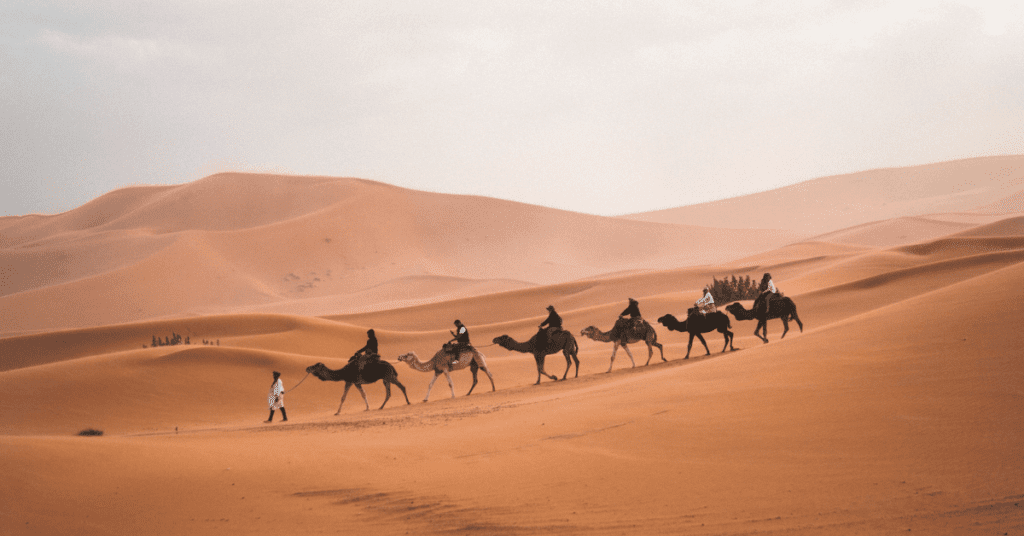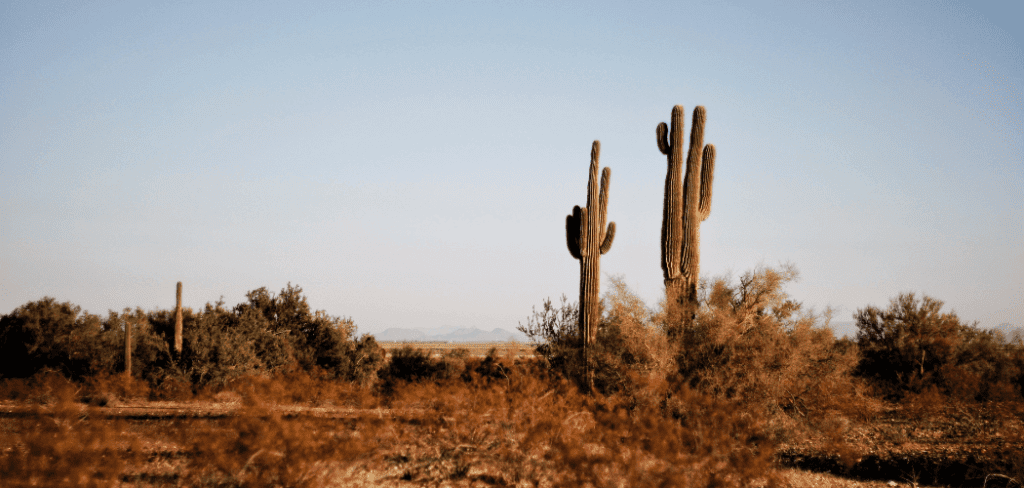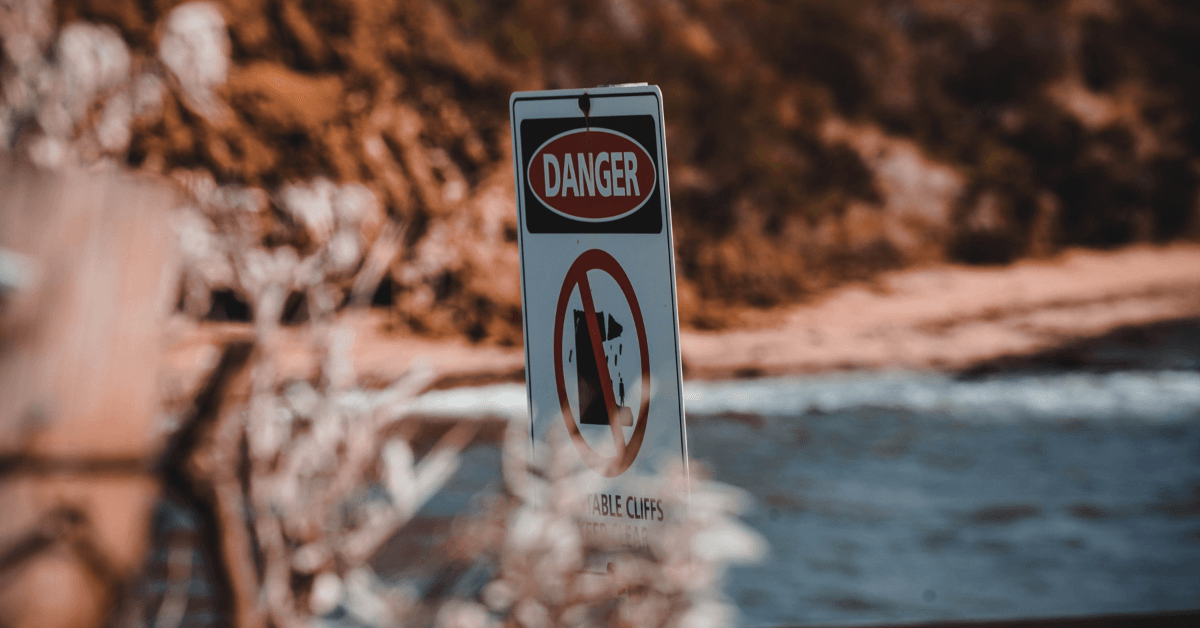The desert is a fascinating and mysterious landscape, rich in beauty and adventure. However, as all outdoor enthusiasts know, with adventure comes risk. The desert, in particular, can be an extremely challenging environment to navigate, full of potential dangers that can pose a significant threat to those unprepared for its harsh conditions.
Whether you’re planning a desert hike, a camping trip, or any other outdoor activity in the arid wilderness, it’s essential to understand the unique hazards that come with this type of environment. From extreme temperatures to flash floods and venomous wildlife, the desert is filled with dangers that demand respect and preparation.
In this blog post, we’ll explore the 10 reasons why deserts are so dangerous. Each reason is specifically tailored to help you, the outdoor enthusiast and survivalist, better prepare for your desert adventure. So, grab your sunscreen, and water bottle, and let’s dive in!
1. Flash Floods
Flash floods are a severe danger in desert areas, and they can occur with little warning. In this section, we’ll explore the reasons why flash floods are so dangerous and what you can do to stay safe in the event of a flash flood.
A. Desert Terrain
Deserts are characterized by dry, sandy terrain that absorbs water poorly. When heavy rain falls in desert areas, the water has nowhere to go, and it can quickly accumulate, causing flash floods. The dry terrain also means that the water can flow very quickly, making it difficult to escape.
B. Unpredictable Weather
Deserts are known for their extreme temperatures, but they can also experience sudden changes in weather patterns. Storms can develop quickly in desert areas, and they can be accompanied by heavy rain and lightning.
It’s crucial to check the weather forecast before heading out on a desert adventure and to be prepared for sudden changes in weather conditions.
C. Deadly Force
Flash floods can be incredibly dangerous, with the potential to cause significant damage and loss of life. The water can be incredibly powerful, sweeping away vehicles and people, and causing buildings to collapse. It’s crucial to avoid low-lying areas and to seek higher ground if a flash flood warning is issued.
D. Preparation is Key
Being prepared for a flash flood is essential for staying safe in the desert. Before heading out on a trip, it’s essential to research the area’s weather patterns and to check for any flash flood warnings. You should also carry a weather radio and a personal locator beacon, which can help you to stay connected and alert in the event of an emergency.
2. Human Factors

While the desert can be dangerous on its own, human factors can also contribute to the risks and challenges of exploring this unique environment. Here are some of the reasons why human factors can be a danger in the desert and what you can do to mitigate them.
A. Overconfidence
One of the biggest dangers of exploring the desert is overconfidence. Many people assume that because they have experience in other outdoor environments or are well-prepared, they can handle anything the desert throws their way.
This overconfidence can lead to underestimating the risks and making poor decisions that can result in danger or even death. To mitigate the danger of overconfidence, it’s important to approach the desert with humility, respect, and an understanding of its unique challenges.
B. Lack of Experience
Another danger of exploring the desert is a lack of experience. If you’re new to desert environments or outdoor exploration in general, you may be unaware of the risks and challenges that come with it. This lack of experience can lead to poor decision-making, taking unnecessary risks, and being unprepared for emergencies.
To mitigate the danger of lack of experience, it’s important to seek out education and training, start small with short trips and gradually increase the difficulty level, and always be open to learning from experienced guides and fellow explorers.
C. Group Dynamics
Group dynamics can also contribute to the danger of exploring the desert. When exploring with a group, there can be pressure to conform to the group’s decisions, even if they are unsafe or unwise. This can also lead to a false sense of security, where individuals assume someone else will take care of the planning, decision-making, or emergency response.
To mitigate the danger of group dynamics, it’s important to establish clear communication and decision-making protocols, assign responsibilities and roles, and prioritize safety over the desire to conform or please others.
D. Cultural Awareness
In some desert regions, there may be cultural factors that can add to the risks of exploration. For example, certain areas may be sacred or off-limits to outsiders, and violating these cultural norms can lead to conflict or danger.
To eliminate or mitigate the danger of cultural factors, it’s important to research the local customs and traditions before traveling, show respect and sensitivity to the local culture, and seek out guidance and advice from local experts or guides.
3. Psychological Stress
Surviving in the desert is not only physically challenging, but it can also take a toll on your mental health. The isolation, extreme conditions, and constant need to be alert can create psychological stress. Here are some of the ways the desert can affect your mental health and what you can do to cope with the stress.
A. Isolation
One of the most significant psychological challenges of the desert is isolation. Being in a vast, empty landscape with few other people or signs of civilization can make you feel alone and vulnerable. To cope with isolation, it’s important to stay in contact with loved ones and to plan regular check-ins with others if possible.
B. Lack of Control
In the desert, it’s easy to feel like you have little control over your situation. The extreme temperatures, lack of water and food, and potential dangers from wildlife can create a sense of helplessness. To cope with this, it’s essential to focus on the things you can control, such as your preparedness and decision-making skills.
C. Fear and Anxiety
The desert can also create fear and anxiety due to the potential dangers present. Venomous wildlife, flash floods, and extreme temperatures can all create feelings of fear and panic. To cope with fear and anxiety, it’s important to practice mindfulness and relaxation techniques, such as deep breathing and visualization.
D. Preparedness and Prevention
To cope with the psychological stress of the desert, it’s essential to be prepared and to take preventative measures. Knowing you have the necessary equipment and supplies can help ease anxiety and create a sense of control over the situation.
Additionally, it’s important to stay informed and aware of potential dangers, as knowledge and awareness can help ease fear and anxiety.
4. Navigation Difficulties
Navigating through the desert can be challenging, even for experienced hikers and outdoors enthusiasts. The lack of visible landmarks and extreme temperatures can make it easy to become disoriented and lost. Here are some of the most common navigation difficulties you may encounter in the desert and what you can do to overcome them.
A. Lack of Visible Landmarks
Unlike other terrains, such as forests or mountains, deserts lack visible landmarks that can help guide your way. This can make it difficult to stay on course and easy to get lost. To overcome this challenge, it’s essential to have a reliable map and compass and to know how to use them.
B. Extreme Temperatures
The extreme temperatures of the desert can also make navigation challenging. Heat exhaustion and dehydration can lead to confusion and disorientation, making it difficult to find your way back to your starting point. To avoid this, it’s essential to carry enough water and electrolyte replacement beverages to stay hydrated and to take breaks in shaded areas to avoid overexposure to the sun.
C. Sandstorms
Sandstorms are another significant challenge that can make navigation difficult in the desert. These storms can create low visibility and make it challenging to see even a few feet in front of you. If you find yourself caught in a sandstorm, it’s essential to stop and take shelter until the storm passes.
D. Preparedness and Prevention
To overcome the challenges of navigating in the desert, it’s crucial to be prepared and to take preventative measures. Before heading out on a trip, it’s important to research the area and to familiarize yourself with the terrain.
You should also bring plenty of water, food, and emergency supplies such as a first aid kit and a satellite phone.
5. Venomous Wildlife

Deserts are home to a wide range of wildlife, including many species that are venomous and potentially dangerous to humans. In this section, we’ll explore some of the most common venomous wildlife found in desert areas and what you can do to stay safe.
A. Snakes
Desert areas are home to many species of snakes, including the venomous rattlesnake, coral snake, and sidewinder. These snakes can be dangerous and potentially deadly, and it’s crucial to be able to identify them to avoid contact. If you encounter a snake, it’s essential to give it a wide berth and to back away slowly.
B. Scorpions
Scorpions are another common venomous creature found in desert areas, and they can be found both on land and in water. Their stings can be painful and cause a range of symptoms, including swelling and numbness.
To avoid being stung, it’s crucial to wear protective clothing and footwear and to shake out your bedding before settling in for the night.
C. Spiders
Several species of venomous spiders can be found in desert areas, including the black widow and brown recluse. These spiders can cause severe reactions, including muscle pain, fever, and nausea.
To avoid contact with venomous spiders, it’s essential to be aware of your surroundings and to avoid putting your hands or feet into dark, enclosed spaces.
D. Preparedness and Prevention
Preparedness and prevention are essential for staying safe from venomous wildlife in desert areas. Before heading out on a trip, it’s crucial to research the wildlife in the area and to be able to identify venomous species. You should also carry a snakebite kit and know how to use it in the event of an emergency.
6. Air Quality
Air quality is another major issue that outdoor enthusiasts should be aware of when exploring desert regions. Dust storms and wildfires are common occurrences in deserts, which can lead to poor air quality and respiratory issues. In addition, many deserts have high levels of air pollution, which can exacerbate pre-existing respiratory conditions or cause new ones to develop.
Dust storms are one of the most dangerous weather phenomena in deserts, and they can cause serious respiratory problems. When a dust storm occurs, the air is filled with dust and other particulate matter, which can cause irritation, inflammation, and even lung damage if inhaled over a prolonged period.
It’s essential to take shelter during a dust storm and protect your eyes, nose, and mouth with a mask or cloth.
Wildfires are also a common occurrence in deserts, especially during the hot and dry summer months. These fires can produce thick smoke that can reduce visibility and create breathing problems. If you are caught in a wildfire, seek shelter immediately, and try to find a location that has good air quality.
If you are traveling to a desert area during wildfire season, be sure to check the local fire reports and avoid areas where there is an active fire.
Finally, air pollution is another issue that can affect air quality in deserts. Many deserts are located near major cities or industrial centers, which can lead to high levels of pollution from factories, vehicles, and other sources.
It’s important to check the air quality index in the area you plan to visit and take precautions if the levels are high. This could include wearing a mask or changing your outdoor plans to reduce exposure to pollution.
7. Vehicle Breakdowns
If you’re planning on exploring the desert by vehicle, it’s essential to be prepared for the possibility of a breakdown. Here are some of the reasons why vehicle breakdowns are a common danger in the desert and what you can do to prevent and manage them.
A. Rough Terrain
The rough terrain of the desert can take a toll on your vehicle’s tires, suspension, and other parts. Rocks, sand, and gravel can cause damage to your vehicle and increase the likelihood of a breakdown. To prevent breakdowns due to rough terrain, it’s important to have sturdy tires and a well-maintained suspension system.
B. Extreme Temperatures
The extreme temperatures of the desert can also contribute to vehicle breakdowns. Heat can cause your battery to die or weaken, and high temperatures can cause your engine to overheat.
To prevent breakdowns due to extreme temperatures, it’s important to have a well-maintained cooling system, carry extra water for your radiator, and avoid driving during the hottest parts of the day.
C. Lack of Maintenance
Vehicle breakdowns can also occur due to lack of maintenance. Neglecting regular maintenance, such as oil changes and fluid checks, can cause parts to wear out or break down. To prevent breakdowns due to lack of maintenance, it’s important to have your vehicle regularly serviced by a qualified mechanic.
D. Preparedness and Prevention
To prevent and manage vehicle breakdowns in the desert, it’s essential to be prepared. This means having a basic understanding of vehicle mechanics, carrying necessary tools and spare parts, and having a plan for what to do in the event of a breakdown. It’s also important to have a communication device, such as a satellite phone or radio, to call for help if needed.
Related: Why Is The Desert Dangerous At Night?
8. Geographical Features

When it comes to geographical features, deserts have a unique set of challenges that can make them dangerous for outdoor enthusiasts. Here are some reasons why:
- Sand Dunes: While they may be beautiful to look at, sand dunes can pose a serious risk to hikers and off-road drivers. They are constantly shifting and can be difficult to navigate, leading to disorientation and the risk of getting lost.
- Canyons: Canyons in the desert can be narrow and deep, making them treacherous to hike through. It’s easy to slip and fall, and the walls can be so steep that it’s impossible to climb out without assistance.
- Rock Formations: The unique rock formations found in deserts, such as arches and hoodoos, can be breathtaking to see. However, they can also be dangerous to climb on. The rocks can be unstable and crumble beneath your feet, leading to falls and injuries.
- Caves: Caves in the desert can be dark and difficult to navigate, especially if you’re not familiar with the area. They can also be home to dangerous wildlife such as snakes and scorpions.
- Dry Washes: Dry washes, also known as arroyos, are channels that are dry most of the time but can fill with water during flash floods. If you’re caught in a dry wash during a flash flood, it can be deadly.
- Salt Flats: Salt flats may look like flat, easy terrain to walk on, but they can be deceiving. The salt can be slippery and difficult to walk on, and it’s easy to become disoriented in the vast, flat landscape.
- Mountains: Deserts are often surrounded by mountains, which can be difficult to climb and hike through. The terrain can be steep and rugged, and temperatures can drop rapidly at higher elevations.
- Oasis: While oases may seem like a haven in the desert, they can also be dangerous. They are often located in remote areas, making them difficult to access, and can be home to dangerous wildlife.
- Sandstorms: Sandstorms can be a common occurrence in deserts and can last for hours or even days. They can be dangerous to anyone caught outside, as the blowing sand can cause injuries and disorientation.
- Heat Mirage: Heat mirages, also known as Fata Morgana, are optical illusions caused by the refraction of light in hot air. They can be disorienting and can make it difficult to navigate, especially if you’re not familiar with the area.
These are just a few examples of the geographical features that can make deserts dangerous for outdoor enthusiasts. Again, it’s important to be prepared and knowledgeable before embarking on any desert adventure to avoid potential dangers.
9. Scarcity of Food
The desert is a harsh environment, and finding food can be a significant challenge for those unprepared for its conditions. In this section, we’ll explore the reasons why the scarcity of food is one of the significant dangers of the desert.
A. Limited Vegetation
The desert is characterized by its barren landscapes, and finding vegetation can be challenging. Even in areas where vegetation is present, it may not be safe to consume, as many plants are toxic to humans.
Therefore, it’s essential to be familiar with the local flora and fauna and carry sufficient food supplies to sustain you during your trip.
B. Scarcity of Water
Water is scarce in the desert, and it can be challenging to find a reliable source. While you can survive for a while without food, dehydration can set in quickly, leading to severe health issues. Therefore, it’s crucial to carry enough water with you, as well as a water filtration system to purify any water you may find.
C. Limited Animal Life
The desert is not an ideal habitat for most animals, and those that do live there tend to be small and elusive. Hunting for food in the desert is a significant challenge, and it’s essential to be familiar with the local wildlife and their behavior.
It’s also important to remember that hunting is illegal in many desert areas, so it’s best to rely on other food sources.
D. Spoilage
Food spoilage can also be a significant issue in the desert, where extreme temperatures can cause food to spoil quickly. It’s essential to pack food that can withstand high temperatures, such as dried fruit and beef jerky, and to keep your food in insulated containers to maintain its freshness.
10. Extreme Temperatures
The desert is known for its extreme temperatures, with scorching hot days and freezing cold nights. These temperature swings can be dangerous, leading to heat exhaustion, dehydration, hypothermia, and even death. In this section, we’ll explore the three main temperature-related dangers of the desert.
A. Daytime Heat
The daytime heat in the desert can be brutal, with temperatures that can exceed 100 degrees Fahrenheit. The intense heat can cause dehydration, heat exhaustion, heatstroke, and other heat-related illnesses. To avoid heat-related issues, it’s essential to stay hydrated by drinking plenty of water, wearing loose and breathable clothing, and taking frequent breaks in the shade.
It’s also crucial to avoid outdoor activities during the hottest parts of the day, typically from mid-morning to mid-afternoon.
B. Nighttime Cold
Contrary to popular belief, the desert can get extremely cold at night, with temperatures dropping below freezing in some areas. Hypothermia is a significant risk during the nighttime, especially for those who are not adequately prepared for the cold.
To avoid hypothermia, it’s crucial to bring warm clothing, such as layers, a hat, and gloves, to keep your body heat in. A good quality sleeping bag and a sleeping pad are also essential to keep you off the cold ground.
C. Temperature Fluctuations
Temperature fluctuations are another significant danger in the desert, with temperatures changing rapidly from day to night. The sudden shift in temperature can be shocking to the body and can lead to a range of issues, such as dehydration, heat exhaustion, and hypothermia.
To avoid these problems, it’s essential to be prepared for temperature fluctuations by bringing appropriate clothing, such as layers, and being mindful of changes in the weather.
